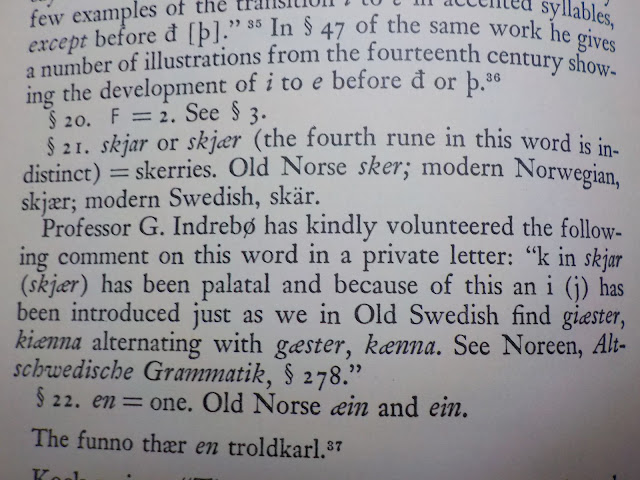LOCATING THE SITE OF THE KENSINGTON RUNESTONE MASSACRE--Finding the Elusive "Lake With Two Skerries."
This posting is about solving a mystery. By putting many clues together, I believe I have discovered where the "Lake With Two Skerries" referred to in the inscription carved into the KRS is located. Much of the material contained in this blog presentation was provided to the Minnesota Historical Society a few short years ago, where it is presently archived within the KRS documentation holdings.
Not by coincidence, I believe, a medieval Scandinavian battle axe was found in 1894 (four years before the KRS was unearthed), a foot and a half deep on the west bank of Davidson Lake, which is about one day's journey north from Runestone Hill. My belief is that the exact finding spot of the battle axe helps to verify--like a time capsule--where the KRS campsite was likely located by this lake with two small islands. In its inscription, the KRS indicates that a bloody massacre occurred where the men were camped by this lake.
My purpose in this blog posting is to help corroborate the message inscribed on the KRS, thereby also helping to corroborate the genuineness of the KRS itself. In this regard, I wish to thank the Kensington Area Heritage Society for giving me--a few years ago--the opportunity of sharing with the local community an earlier presentation of my recent discoveries.
Given below (from the above-pictured book) is Hjalmar R. Holand's very early rendition of the message carved into the KRS:
For the scholar, just below are two pages (162 and 163) from the book shown above that deal with the use of a specific rune having to do with a translation of the word "skerries." Then follows another page (188) from the same book that deals with an aspect of the massacre from Holand's point of view. He concludes the paragraph by emphasizing: "If this lake with the two skerries could be found, we would have promising corroboration of the truth of the inscription."
From another of Holand's books, pictured above, is a further, detailed explanation for a translation of the word "skerries," this excerpt being from page 298. Then following is an affidavit (page 222) from old Martha Davidson, affirming the details of the finding of the "Erdahl Axe" by her husband, Julius. Then, on the following page, 223, is Holand's excellent detailed report on precisely where the Erdahl Axe was found. This very detailed report is what enabled me to find the probable location of the massacre site on the west bank of Davidson Lake, which is the last of a succession of lakes just off the Chippewa River, the same river that flows down within a few miles west of Runestone Hill. Finally, a page is given (Plate XXIII) from the same book pictured above showing what the Erdahl Axe looks like.
Ironically, Holand didn't realize he was standing on the likely massacre site by the lake with two skerries because he was looking way too far north!
What follows--and to conclude this treatise--are about a dozen pages I copied from an earlier power-point presentation I prepared on this subject.
Not by coincidence, I believe, a medieval Scandinavian battle axe was found in 1894 (four years before the KRS was unearthed), a foot and a half deep on the west bank of Davidson Lake, which is about one day's journey north from Runestone Hill. My belief is that the exact finding spot of the battle axe helps to verify--like a time capsule--where the KRS campsite was likely located by this lake with two small islands. In its inscription, the KRS indicates that a bloody massacre occurred where the men were camped by this lake.
My purpose in this blog posting is to help corroborate the message inscribed on the KRS, thereby also helping to corroborate the genuineness of the KRS itself. In this regard, I wish to thank the Kensington Area Heritage Society for giving me--a few years ago--the opportunity of sharing with the local community an earlier presentation of my recent discoveries.
Given below (from the above-pictured book) is Hjalmar R. Holand's very early rendition of the message carved into the KRS:
For the scholar, just below are two pages (162 and 163) from the book shown above that deal with the use of a specific rune having to do with a translation of the word "skerries." Then follows another page (188) from the same book that deals with an aspect of the massacre from Holand's point of view. He concludes the paragraph by emphasizing: "If this lake with the two skerries could be found, we would have promising corroboration of the truth of the inscription."
From another of Holand's books, pictured above, is a further, detailed explanation for a translation of the word "skerries," this excerpt being from page 298. Then following is an affidavit (page 222) from old Martha Davidson, affirming the details of the finding of the "Erdahl Axe" by her husband, Julius. Then, on the following page, 223, is Holand's excellent detailed report on precisely where the Erdahl Axe was found. This very detailed report is what enabled me to find the probable location of the massacre site on the west bank of Davidson Lake, which is the last of a succession of lakes just off the Chippewa River, the same river that flows down within a few miles west of Runestone Hill. Finally, a page is given (Plate XXIII) from the same book pictured above showing what the Erdahl Axe looks like.
Ironically, Holand didn't realize he was standing on the likely massacre site by the lake with two skerries because he was looking way too far north!
What follows--and to conclude this treatise--are about a dozen pages I copied from an earlier power-point presentation I prepared on this subject.




























Comments
Post a Comment